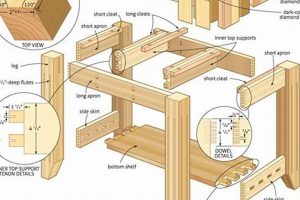The creation of functional or decorative items from wood is an established practice. These endeavors range from simple constructions, such as birdhouses or cutting boards, to more complex undertakings, including furniture building and intricate carvings. They often involve the use of hand tools, power tools, and a variety of woodworking techniques to shape and assemble the material.
The appeal of crafting items from timber stems from several factors. It allows for the creation of custom pieces tailored to specific needs and aesthetic preferences. Furthermore, engaging in such activities can provide a sense of accomplishment, foster creativity, and offer a tangible connection to craftsmanship traditions. Historically, the ability to work with wood has been essential for shelter construction, tool making, and artistic expression across various cultures.
Understanding joinery techniques, wood selection, and finishing methods are foundational elements for successful execution. The subsequent sections will delve into specific aspects of these activities, exploring various project types, safety considerations, and best practices for achieving desired outcomes.
Woodworking Project Tips
The following guidelines aim to improve the execution and outcome of various crafts involving timber. Proper planning and technique are essential for both safety and achieving desired results.
Tip 1: Material Selection: Employ wood species appropriate for the intended purpose. Consider factors such as hardness, grain pattern, and moisture resistance when choosing lumber.
Tip 2: Accurate Measurement and Layout: Precise measurements are crucial for achieving tight-fitting joints and accurate dimensions. Utilize marking gauges and sharp pencils to ensure accuracy during layout.
Tip 3: Sharp Tools are Essential: Dull tools require more force, increasing the risk of accidents and producing poor cuts. Regularly sharpen chisels, plane blades, and saw blades to maintain optimal performance.
Tip 4: Prioritize Safety: Always wear appropriate safety gear, including eye protection, hearing protection, and respiratory protection when operating power tools or working with finishes. Understand the safety features and limitations of each tool.
Tip 5: Master Joint Selection: Choose joinery methods appropriate for the strength and aesthetic requirements of the project. Mortise and tenon joints, dovetail joints, and rabbet joints each offer varying levels of strength and visual appeal.
Tip 6: Proper Wood Preparation: Ensure that lumber is properly acclimatized to the workshop environment to minimize warping or cracking after assembly. Surfacing and dimensioning lumber to the correct thickness and width is critical.
Tip 7: Finishing Techniques: Select a finish that provides adequate protection and enhances the natural beauty of the wood. Proper surface preparation, including sanding and cleaning, is essential for achieving a smooth and durable finish.
Adhering to these principles will contribute to increased efficiency, improved project quality, and a safer working environment. Understanding fundamental woodworking concepts will enable the successful completion of a wide range of endeavors.
The subsequent section will explore common mistakes to avoid in order to further refine skills and improve project success.
1. Precise material selection
The foundation of successful crafting involving wood lies in the judicious selection of appropriate materials. The properties of the wood directly influence the structural integrity, aesthetic appeal, and longevity of the final product. Therefore, an informed decision regarding material is paramount to achieving desired outcomes.
- Wood Species and Project Requirements
The choice of wood species must align with the demands of the project. For instance, a load-bearing structure, such as a table leg, necessitates a hardwood species with high compressive strength, such as maple or oak. Conversely, a purely decorative element might utilize a softer, more easily carved wood like basswood. Incorrect species selection can lead to structural failure or difficulty in achieving the desired aesthetic.
- Moisture Content and Stability
The moisture content of the wood is a critical factor in its stability and susceptibility to warping or cracking. Wood that is too wet will shrink and distort as it dries, while wood that is too dry may become brittle. Utilizing kiln-dried lumber with an appropriate moisture content for the intended environment is essential for minimizing these risks and ensuring long-term stability of the finished product.
- Grain Pattern and Visual Appeal
The grain pattern of wood significantly impacts the visual appeal of the finished project. Straight-grained wood is often preferred for structural components due to its strength and stability, while figured wood, such as curly maple or burl, can add visual interest to decorative elements. Careful consideration of grain pattern is crucial for achieving the desired aesthetic effect.
- Defect Identification and Avoidance
Wood is a natural material and may contain defects such as knots, checks, or wane. Identifying and avoiding these defects during material selection is crucial for ensuring the structural integrity and aesthetic quality of the finished project. Strategic placement of components can sometimes mitigate the impact of minor defects; however, severely compromised pieces should be rejected.
The interrelationship between wood species, moisture content, grain pattern, and defect identification underscores the importance of precise material selection in all crafting involving wood. Informed decision-making in this phase directly contributes to the durability, stability, and visual appeal of the completed project. Neglecting these considerations can lead to structural failures, aesthetic compromises, and ultimately, project failure.
2. Detailed design planning
The success of any woodworking endeavor is intrinsically linked to the comprehensiveness of its initial design phase. Detailed design planning, encompassing precise measurements, material calculations, and structural considerations, serves as the blueprint for the entire process. A deficient plan inevitably leads to inaccuracies, material waste, and potential structural weaknesses in the final product. For instance, neglecting to account for wood shrinkage during the design of a large tabletop can result in significant dimensional discrepancies post-construction.
A thorough design phase extends beyond mere dimensional considerations. It includes the selection of appropriate joinery techniques based on anticipated load-bearing requirements, as well as the pre-emptive identification and mitigation of potential challenges. The design of a complex piece of furniture, such as a dovetailed chest of drawers, necessitates a meticulous plan to ensure proper alignment, drawer functionality, and overall structural integrity. Furthermore, consideration of the wood grain direction, hardware placement, and finishing techniques are all integral components of a well-defined design.
In summation, detailed design planning is not merely a preliminary step, but a critical determinant of a woodworking project’s ultimate success. While unforeseen challenges may arise during the execution phase, a robust and well-considered design significantly minimizes the potential for costly errors, ensures structural soundness, and ultimately contributes to a high-quality and aesthetically pleasing final product. The investment of time and effort in thorough design planning invariably yields a substantial return in the form of a more efficient, accurate, and satisfying woodworking experience.
3. Accurate tool utilization
The achievement of precision and quality in crafting with wood is fundamentally contingent upon the accurate utilization of tools. Each tool, from the simplest hand plane to the most sophisticated power saw, possesses specific design characteristics and operational parameters that must be understood and respected. Failure to adhere to these principles invariably leads to inaccurate cuts, compromised joinery, and an overall degradation of the final product. The construction of a simple box, for example, necessitates precise miter cuts to achieve tight-fitting corners; inaccuracy in this step results in unsightly gaps and a structurally unsound assembly.
Beyond the mechanical aspects, accurate tool utilization encompasses a deep understanding of the interaction between the tool and the wood. Factors such as grain direction, wood hardness, and cutting speed all influence the quality of the cut. Attempting to force a dull chisel against the grain, for instance, results in tear-out and a rough surface. Similarly, using an incorrect saw blade for a specific wood type can lead to splintering and an uneven cut. Therefore, selecting the appropriate tool and employing it correctly is critical for achieving the desired level of precision and finish.
In conclusion, accurate tool utilization is not merely a technical skill, but a fundamental principle that underpins all successful activities involving wood. Mastery of this principle requires a combination of theoretical knowledge, practical experience, and a meticulous attention to detail. While the acquisition of such skills requires dedicated practice, the rewards are substantial, resulting in high-quality, aesthetically pleasing, and structurally sound final products. The challenges lie in consistently applying these principles across a wide range of projects and tool types, but the practical significance of this understanding is undeniable.
4. Sound joinery execution
The longevity and structural integrity of a woodworking project are directly proportional to the quality of its joinery. Joinery represents the method by which individual wood components are connected to form a cohesive whole. Flawed joinery, regardless of the aesthetic appeal of other elements, undermines the entire endeavor, leading to premature failure or functional impairment. For example, a poorly executed dovetail joint in a drawer front will inevitably separate under repeated use, rendering the drawer unusable.
The selection and execution of joinery techniques should be dictated by the specific demands of the project. A delicate jewelry box may require only simple mitered joints, whereas a robust dining table necessitates stronger mortise-and-tenon or dovetail joinery to withstand the stresses of daily use. Precise cutting, accurate fitting, and the judicious application of adhesives are all critical components of sound joinery execution. Omission of any one of these elements compromises the strength and stability of the connection. The stability of a chair, for example, relies heavily on the correct assembly of its joints.
Ultimately, sound joinery execution is not merely a technical skill but a fundamental principle of responsible woodworking. While aesthetic considerations are important, they should never supersede the need for structural integrity. A well-executed joint is a testament to the craftsman’s understanding of material properties and the forces at play within the assembled structure. Therefore, mastery of joinery techniques is essential for any woodworker seeking to create durable, functional, and aesthetically pleasing creations.
5. Durable finish application
The application of a durable finish is a crucial final stage in woodworking projects, directly influencing the longevity, aesthetic appeal, and functional performance of the crafted object. The finish serves as a protective barrier against environmental factors, physical wear, and chemical damage, thereby preserving the underlying wood and enhancing its inherent beauty. The selection and application of an appropriate finish are therefore paramount to the overall success of the project.
- Protection against Environmental Factors
Finishes shield wood from moisture, ultraviolet (UV) radiation, and temperature fluctuations. Moisture can cause swelling, warping, and decay, while UV radiation can fade or discolor the wood. A durable finish acts as a barrier against these elements, extending the lifespan of the woodworking project. Marine-grade varnishes, for example, are specifically formulated to withstand harsh marine environments, providing excellent protection against water and UV exposure for wooden boats and outdoor furniture.
- Resistance to Physical Wear
A durable finish provides resistance to scratches, abrasions, and impacts, protecting the wood surface from everyday wear and tear. The choice of finish depends on the intended use of the object. For instance, a polyurethane finish is often applied to hardwood floors due to its high abrasion resistance, while a lacquer finish may be preferred for furniture items where a smoother, more refined surface is desired. The finish ensures its continued performance and appearance.
- Enhancement of Aesthetic Appeal
Finishes can enhance the natural beauty of wood by highlighting its grain pattern, adding depth, and creating a desired sheen. Different finishes offer varying levels of gloss, from matte to high-gloss, allowing for customization of the visual appearance. Stains can be used to alter the wood’s color, while clear finishes allow the natural color to shine through. Proper application enhances visual characteristics. This is evident when comparing furniture pieces.
- Prevention of Chemical Damage
Finishes provide a barrier against household chemicals, such as cleaners, solvents, and spills, preventing staining, discoloration, or damage to the wood surface. The chemical resistance of a finish is particularly important for surfaces that are frequently exposed to spills, such as kitchen countertops or dining tables. Epoxy resins, for example, offer excellent chemical resistance and are often used to protect wood surfaces in laboratory or industrial settings.
The selection and application of a durable finish are integral components of any successful woodworking project. By providing protection against environmental factors, physical wear, chemical damage, and enhancing aesthetic appeal, a well-chosen and properly applied finish ensures the longevity, functionality, and visual appeal of the crafted object. The careful consideration of these factors is essential for achieving a result that will endure for years to come.
Frequently Asked Questions About Woodworking Projects
This section addresses common inquiries regarding crafting items from wood. The following questions and answers aim to provide clarity and guidance for individuals pursuing such activities.
Question 1: What is the minimum workspace required for engaging in woodworking projects?
The spatial requirements vary depending on the scale of the endeavor. Smaller endeavors, such as box construction, can be accommodated in confined areas. Larger endeavors, such as furniture creation, necessitate a dedicated workspace with adequate room for material storage, tool operation, and assembly.
Question 2: What are the essential safety precautions that must be observed?
Eye protection, hearing protection, and respiratory protection are indispensable. Furthermore, individuals must familiarize themselves with the safe operation of all tools and machinery. Proper ventilation is crucial when working with finishes and adhesives.
Question 3: How does one select the appropriate wood for a given endeavor?
Wood selection is contingent upon the structural requirements, aesthetic considerations, and environmental factors to which the finished product will be exposed. Hardwoods are generally preferred for load-bearing applications, while softwoods are suitable for decorative elements. Moisture content and grain pattern are also critical factors.
Question 4: What are the most common joinery techniques employed?
Common joinery techniques include mortise and tenon, dovetail, miter, and lap joints. The choice of technique depends on the strength requirements and aesthetic preferences of the project. Proper execution of joinery is crucial for structural integrity.
Question 5: What are the different types of wood finishes available?
Numerous finishes are available, including varnishes, lacquers, oils, and waxes. The selection of finish depends on the desired level of protection, aesthetic effect, and ease of application. Proper surface preparation is essential for achieving a durable and visually appealing finish.
Question 6: How can one minimize material waste in projects involving timber?
Careful planning, precise measurement, and efficient layout are essential for minimizing waste. Optimizing cutting patterns and utilizing scrap wood for smaller components can further reduce material consumption.
These responses offer a general overview of common considerations. Detailed knowledge and practical experience are essential for successful execution.
The following section will delve into specific activities involving wood, examining their unique challenges and opportunities.
Conclusion
This exploration has underscored the multifaceted nature of crafting objects from timber. Material selection, design precision, tool competence, joinery expertise, and finish application are critical elements that determine the success and longevity of such endeavors. A failure to address any one of these aspects can compromise the overall outcome, resulting in structural deficiencies or aesthetic shortcomings.
The ongoing pursuit of knowledge and skill refinement is essential for those engaged in these activities. By prioritizing safety, embracing best practices, and continuously seeking to improve their craft, individuals can create items of lasting value and contribute to the rich tradition of working with wood. Further exploration into advanced techniques and innovative designs will undoubtedly shape the future of crafting objects from timber, ensuring its continued relevance and appeal for generations to come.







